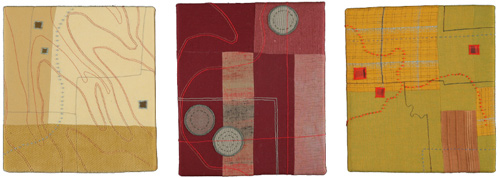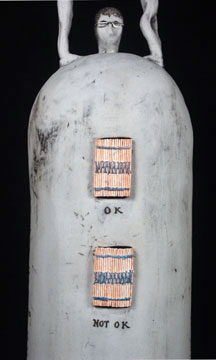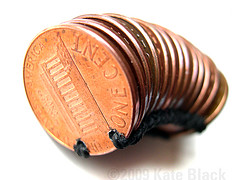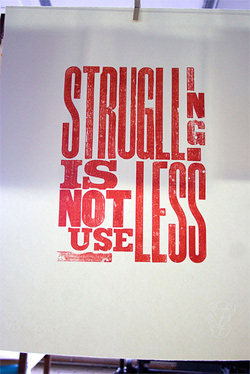
With my recent interests in maps as well as my own-going attempt at writing haiku, the other day I enjoyed browsing Leah Evan’s map-inspired quilts. Some of them (like the 3 above) are called “map haiku.” You can see more on her website.

With my recent interests in maps as well as my own-going attempt at writing haiku, the other day I enjoyed browsing Leah Evan’s map-inspired quilts. Some of them (like the 3 above) are called “map haiku.” You can see more on her website.
The Medieval ancestors of today’s graphic designers created ‘model’ or ‘pattern’ books to show their work to potential clients. Only a handful survive and the British Library is currently raising money to acquire an example of “outstanding significance” — the so-called Macclesfield Alphabet Book, a book that has been in the Earls of Macclesfield library since the 1750s. Below are a few more pictures, and go here to see even more.

 In another week I’ll be taking a day off to go to the Codex International Book Fair in Berkeley (it’s Mon Feb 9 – Wed Feb 11). I went to the first fair two years ago, not only to see the books, but to see bookish friends and meet some of the authors who generously wrote Ampersand articles for me. This time is no different — I’ll be looking up Steven Daiber owner of Red Trillium Press in Massachusetts, who reviewed an exhibition for Ampersand. Last year he went to Viet Nam through a co-sponsored venture with the Boston Printmakers and the United States Cultural Ambassadors Program where he taught classes and worked on a 12-artist collaborative book celebrating the 1000 year anniversary of Ha Noi. You can see photos of the trip, the making of the book, and also papermaking in Viet Nam on Steven’s flickr pages.
In another week I’ll be taking a day off to go to the Codex International Book Fair in Berkeley (it’s Mon Feb 9 – Wed Feb 11). I went to the first fair two years ago, not only to see the books, but to see bookish friends and meet some of the authors who generously wrote Ampersand articles for me. This time is no different — I’ll be looking up Steven Daiber owner of Red Trillium Press in Massachusetts, who reviewed an exhibition for Ampersand. Last year he went to Viet Nam through a co-sponsored venture with the Boston Printmakers and the United States Cultural Ambassadors Program where he taught classes and worked on a 12-artist collaborative book celebrating the 1000 year anniversary of Ha Noi. You can see photos of the trip, the making of the book, and also papermaking in Viet Nam on Steven’s flickr pages.
![]() One of my friends who has a table is Judy Serebrin (that’s her bookwork “Soul Book: Ok, Not Ok With Me” to the right). In addition to books, she often makes one-of-a-kind pieces of porcelain with small cavities that contain books — the books represent the soul or story of the figure. They all have a peaceful yet enigmatic quality that I find appealing. You can see more about Judy and lots of photos of her work here.
One of my friends who has a table is Judy Serebrin (that’s her bookwork “Soul Book: Ok, Not Ok With Me” to the right). In addition to books, she often makes one-of-a-kind pieces of porcelain with small cavities that contain books — the books represent the soul or story of the figure. They all have a peaceful yet enigmatic quality that I find appealing. You can see more about Judy and lots of photos of her work here.
Matt Sutter illustrates with type. My favorite is this Typebike print that uses Garamond. He’s also got a stag, tiger, octopus and a variety of typewomen.
 In a comment to one of my blog posts, Judith mentioned that she read the Live Journal handmade books community. I hopped over there to take a look, and among other things found this wonderful book made from pennies with a double needle coptic binding from Kate Black. Here’s her post with more about making her penny book. (Kate also sells buttons and mirrors that say Reading is Sexy.)
In a comment to one of my blog posts, Judith mentioned that she read the Live Journal handmade books community. I hopped over there to take a look, and among other things found this wonderful book made from pennies with a double needle coptic binding from Kate Black. Here’s her post with more about making her penny book. (Kate also sells buttons and mirrors that say Reading is Sexy.)
![]() Want to know more about the double needle coptic binding? Read here — search down for “COPTIC STITCH” to find the instructions.
Want to know more about the double needle coptic binding? Read here — search down for “COPTIC STITCH” to find the instructions.
 I keep a small pool of photos on Flickr and I found the photo to the left when looking through some of the groups I belong to. It’s a print by Armina Ghazaryan, a graphic designer living in Gent, Belgium. She made the print from wood type at MIAT, the Museum of Industrial Archaeology and Textile in Gent. (They call themselves “a unique museum that focuses mainly on the fundamental technological changes in our society during the last 250 years.”) But even better are her blog posts about a workshop she took at MIAT last summer. The pictures are great — of the wonderful typographic work of the participants, of old presses, of locked up type. And be sure to scroll down for a look at the photos of a chasse full of lego blocks, all locked up and ready to print.
I keep a small pool of photos on Flickr and I found the photo to the left when looking through some of the groups I belong to. It’s a print by Armina Ghazaryan, a graphic designer living in Gent, Belgium. She made the print from wood type at MIAT, the Museum of Industrial Archaeology and Textile in Gent. (They call themselves “a unique museum that focuses mainly on the fundamental technological changes in our society during the last 250 years.”) But even better are her blog posts about a workshop she took at MIAT last summer. The pictures are great — of the wonderful typographic work of the participants, of old presses, of locked up type. And be sure to scroll down for a look at the photos of a chasse full of lego blocks, all locked up and ready to print.